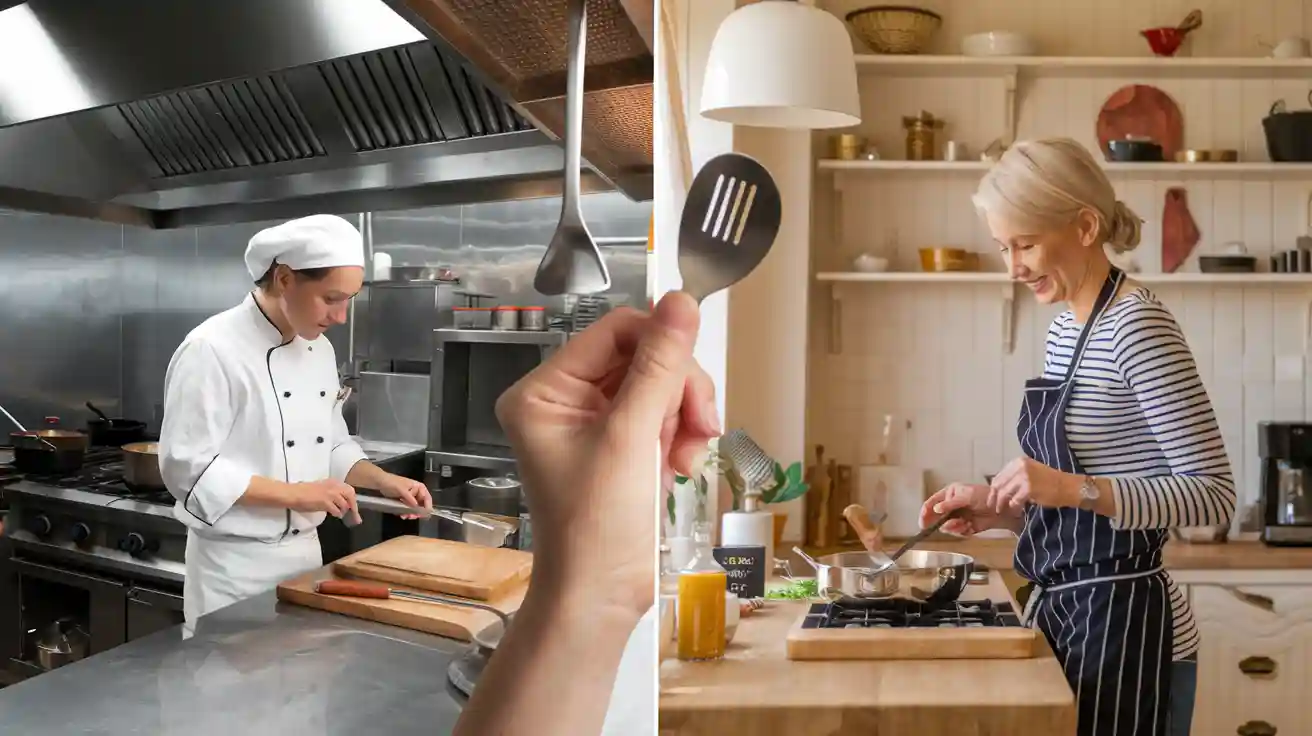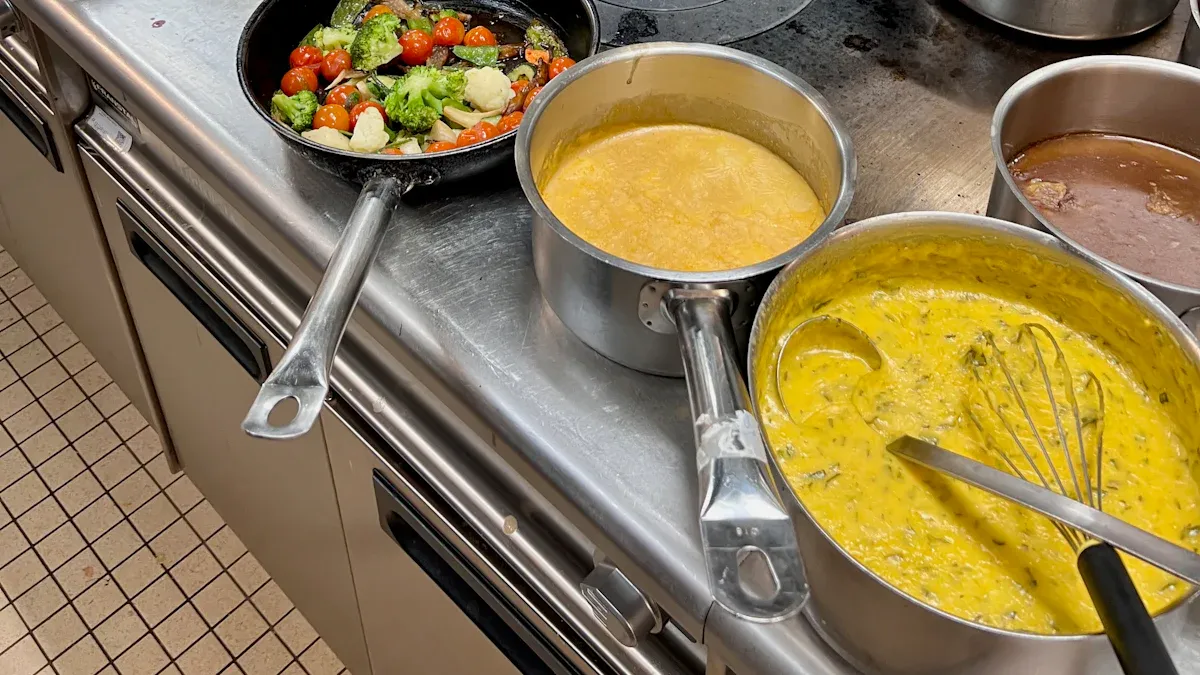
When you pick cooking tools utensils and equipments, your choice often depends on several factors:
- Cost and long-term value
- Kitchen layout and size
- Energy efficiency
- Safety features
- Durability and reliability
Think about how these points fit your needs and kitchen goals.
Key Differences in Cooking Tools Utensils and Equipments
Durability and Build Quality
You will notice that commercial cooking tools utensils and equipments are built for heavy-duty use. Manufacturers use high-grade stainless steel because it resists corrosion and is easy to clean. This material helps prevent bacteria growth and keeps your kitchen safe. Residential equipment often uses lighter materials, which may look nice but do not last as long under constant use.
Tip: Stainless steel equipment lasts longer and needs less maintenance, saving you money over time.
Capacity and Size
Commercial kitchens need to prepare large amounts of food quickly. That is why commercial ovens, mixers, and refrigerators are much bigger than those in most homes. For example, a commercial mixer can handle up to 20 quarts, while a home mixer usually holds less. Residential appliances are smaller and fit better in your kitchen at home.
| Factor | Commercial Appliances | Residential Appliances |
|---|---|---|
| Size | Larger for high volume | Compact for home use |
| Capacity | High, for big batches | Lower, for family meals |
Power and Performance
Commercial appliances use more power to cook food faster and more evenly. A commercial stove can use over 3,000 watts, while a home stove uses less. You may also find that commercial blenders and ovens need special electrical setups because they draw more energy.
Customization and Features
You can customize commercial cooking tools utensils and equipments to fit your needs. Many commercial ranges offer modular designs, extra burners, or built-in grills. These features help chefs work faster and more efficiently. Home equipment focuses more on style and color choices to match your kitchen decor.
Sanitation and Safety Standards
Commercial kitchens must follow strict rules for cleanliness and safety. Equipment must meet NSF/ANSI standards, and kitchens need special sinks, fire safety systems, and ventilation. At home, you do not have to meet these rules, so residential equipment is less complex in this area.
Cost and Value
Commercial equipment costs more at first, sometimes thousands of dollars for a single oven or refrigerator. However, it lasts longer and can save money on repairs and replacements. Residential equipment is cheaper but may not hold up if you use it every day for big meals.
Pros and Cons of Commercial vs. Residential Cooking Tools Utensils and Equipments

Advantages of Commercial Equipment
You gain several benefits when you use commercial cooking tools utensils and equipments, even in a home kitchen:
- Ventless commercial equipment can save you money. You do not need to install expensive ventilation systems, which can cost up to $24,000.
- These machines use less energy and cost less than $2 per day to run.
- You can place ventless equipment in places where normal ventilation is not possible, like older homes or small apartments.
- Modern commercial ovens have easy controls and programmable recipes. You do not need special training to use them.
- Advanced technology, such as automation and smart controls, helps you cook faster and more consistently.
- Commercial equipment is built to last and can handle heavy use.
Tip: Commercial appliances often include safety features and easy-to-clean surfaces, making your kitchen safer and more hygienic.
Drawbacks of Commercial Equipment
You may face some challenges if you choose commercial equipment for your home:
- These appliances are much larger and need more space than most home kitchens offer.
- They produce more heat and often require strong ventilation, which many homes do not have.
- You might need to upgrade your gas or electrical lines, which can be costly.
- Repairs and maintenance often require certified technicians.
- Warranties may not cover home use, so you could pay more for repairs.
- Commercial ovens and stoves can be dangerous for children and pets because of their power and open flames.
Advantages of Residential Equipment
Residential equipment fits your home kitchen better. Here are some key benefits:
- Home appliances are designed for safety and energy efficiency.
- You get features like precise temperature control and powerful burners, similar to commercial models.
- Installation and maintenance are easier and less expensive.
- Many modern ranges offer high-BTU burners and built-in griddles, giving you a near-professional experience.
- You avoid the high costs and risks that come with commercial equipment.
Drawbacks of Residential Equipment
Residential cooking tools have some limits compared to commercial options. See the table below:
| Equipment Type | Residential Limitations | Commercial Advantages |
|---|---|---|
| Refrigerators & Freezers | Smaller size, less robust | Heavy-duty, walk-in options |
| Stoves & Ovens | Lower volume, less durable | High volume, gas-powered |
| Dishwashers | Smaller, lower temperatures | Larger, withstands frequent use |
| Range Hoods | Less powerful, fewer safety features | High-powered, advanced safety |
| Electrical/Gas Setup | Not ready for commercial demands | Proper infrastructure |
You may also find that residential appliances are not built for heavy or frequent use. They can wear out faster if you cook large meals often.
When to Invest in Professional-Grade Cooking Tools Utensils and Equipments
High-Volume Cooking at Home
You may find yourself cooking for a large family or hosting frequent gatherings. If you prepare big meals often, your kitchen tools need to keep up. Commercial-grade equipment, like heavy-duty ranges and large refrigerators, can handle high-volume cooking much better than standard home appliances. These machines work well under pressure and last longer when used every day.
- Commercial ranges and ovens cook food faster and more evenly.
- Large-capacity mixers and food processors save you time with big batches.
- Heavy-duty refrigerators store more food and keep it fresh longer.
Note: Commercial equipment often needs more space and special ventilation. Make sure your kitchen can support these upgrades before you buy.
Starting a Food Business or Side Hustle
If you want to start a small food business or a side hustle from home, you need reliable and efficient equipment. Professional-grade cooking tools utensils and equipments help you meet health and safety standards and keep up with customer demand. Here is a table showing what you might need:
| Equipment Category | Examples of Required Equipment and Tools |
|---|---|
| Kitchen Appliances | Oven and/or stovetop (possibly commercial-grade), Refrigerator and freezer (possibly commercial-grade), Microwave, Food processor, Stand mixer, Dishwasher |
| Food Preparation Tools | High-quality knives, Cutting boards, Measuring cups/spoons, Spatulas, Whisks, Tongs, Mixing bowls, Baking sheets/trays, Timers, Thermometers |
| Storage Solutions | Food-safe containers with airtight lids, Storage racks, Shelving units |
| Packaging Materials | Vacuum sealer, Boxes/bags, Tamper-evident seals, Sealable food containers, Labels/label printer |
| Sanitization and Safety | Sanitizing wipes, Food-safe disinfectant sprays, Dish soap, Handwashing station, Fire extinguisher, First aid kit, PPE |
You may also need to rent a commercial kitchen if your home does not meet state requirements. This step ensures you follow local laws and keep your customers safe.
Specialty Cooking Needs
Some cooking styles require special equipment. If you love baking bread, fermenting foods, or making pastries, you might need commercial-grade tools. For example, professional bread ovens and dough fermentation systems help you get perfect results every time. Brands like CFI and Pavailler make equipment that controls temperature and humidity for baking and fermenting. These tools let you try recipes and techniques that are hard to do with regular home appliances.
Tip: Specialty equipment helps you achieve consistent results and makes advanced cooking projects easier.
Long-Term Value and Durability
When you cook often, you want tools that last. Commercial-grade equipment costs more at first, but it gives you better value over time. These machines are built for heavy use and rarely break down. For example, commercial refrigerators offer more storage and last longer than home models. They use more energy and may not have as many shelves, but they keep your food safe and fresh.
- Commercial microwaves work for hours each day and heat food quickly.
- Heavy-duty construction means fewer repairs and replacements.
- You save money in the long run because you do not need to buy new equipment as often.
| Aspect | Commercial-Grade Equipment | Domestic-Grade Equipment |
|---|---|---|
| Durability | Built for heavy, continuous use; highly robust | Designed for moderate, periodic use |
| Capacity | Larger capacity for high volume | Smaller capacity for household needs |
| Cost | Higher upfront cost | More affordable for homeowners |
| Complexity | More complex features | Simpler, user-friendly design |
| Maintenance | Requires more intensive maintenance | Easier maintenance and parts replacement |
Callout: If you cook every day or run a food business, investing in commercial-grade equipment can save you time and money over the years.
Tips for Choosing the Right Cooking Tools Utensils and Equipments
Assess Your Cooking Frequency and Style
Start by thinking about how often you cook and what types of meals you prepare. If you cook every day or enjoy trying new recipes, you may need sturdy and versatile cooking tools utensils and equipments. For occasional cooking, basic home equipment often works well. Ask yourself if you make large meals for family or friends, or if you focus on quick, simple dishes. Your cooking habits help you decide which tools will serve you best.
Consider Your Kitchen Space and Layout
Your kitchen’s size and shape play a big role in what equipment fits. Commercial kitchens use layouts like galley, island, or zoning to make space for large machines and smooth workflow. These layouts help staff move safely and work together. In a home kitchen, space is usually tighter. Large commercial appliances may not fit or could block movement. Always measure your kitchen and plan where each item will go before you buy.
Tip: Choose equipment that matches your kitchen’s layout. This keeps your workspace safe and efficient.
Set a Realistic Budget
Plan your budget before shopping for new tools. Focus on buying high-quality items that last longer and work better. Make a list of what you really need, and avoid buying extras that take up space. Look for versatile tools that do more than one job. Compare prices, read reviews, and check for safety features. Sometimes, you can find good deals on gently used equipment or consider leasing to save money.
Align with Your Cooking Goals
Think about your long-term kitchen plans. If you want to try new cooking styles or grow your skills, pick equipment that can adapt to your needs. Choose tools that are easy to use, clean, and maintain. Durable and energy-efficient items save money and time over the years. When your equipment matches your goals, you enjoy cooking more and keep your kitchen running smoothly.
- Weigh cost, kitchen layout, energy efficiency, safety, and durability before you choose new equipment.
- ENERGY STAR-certified appliances can save you money over time.
Choose commercial options only when your needs, space, and budget support the investment. Make your decision based on your real cooking habits and future plans.
FAQ
What is the main difference between commercial and residential cooking equipment?
Commercial equipment lasts longer and handles heavy use. You get more power and capacity. Residential equipment fits better in your home and costs less.
Can you use commercial kitchen tools at home?
You can use commercial tools at home. Make sure your kitchen has enough space and proper electrical or gas connections.
How do you decide which type of equipment to buy?
Start by thinking about your cooking habits, kitchen size, and budget. Choose equipment that matches your needs and long-term goals.


